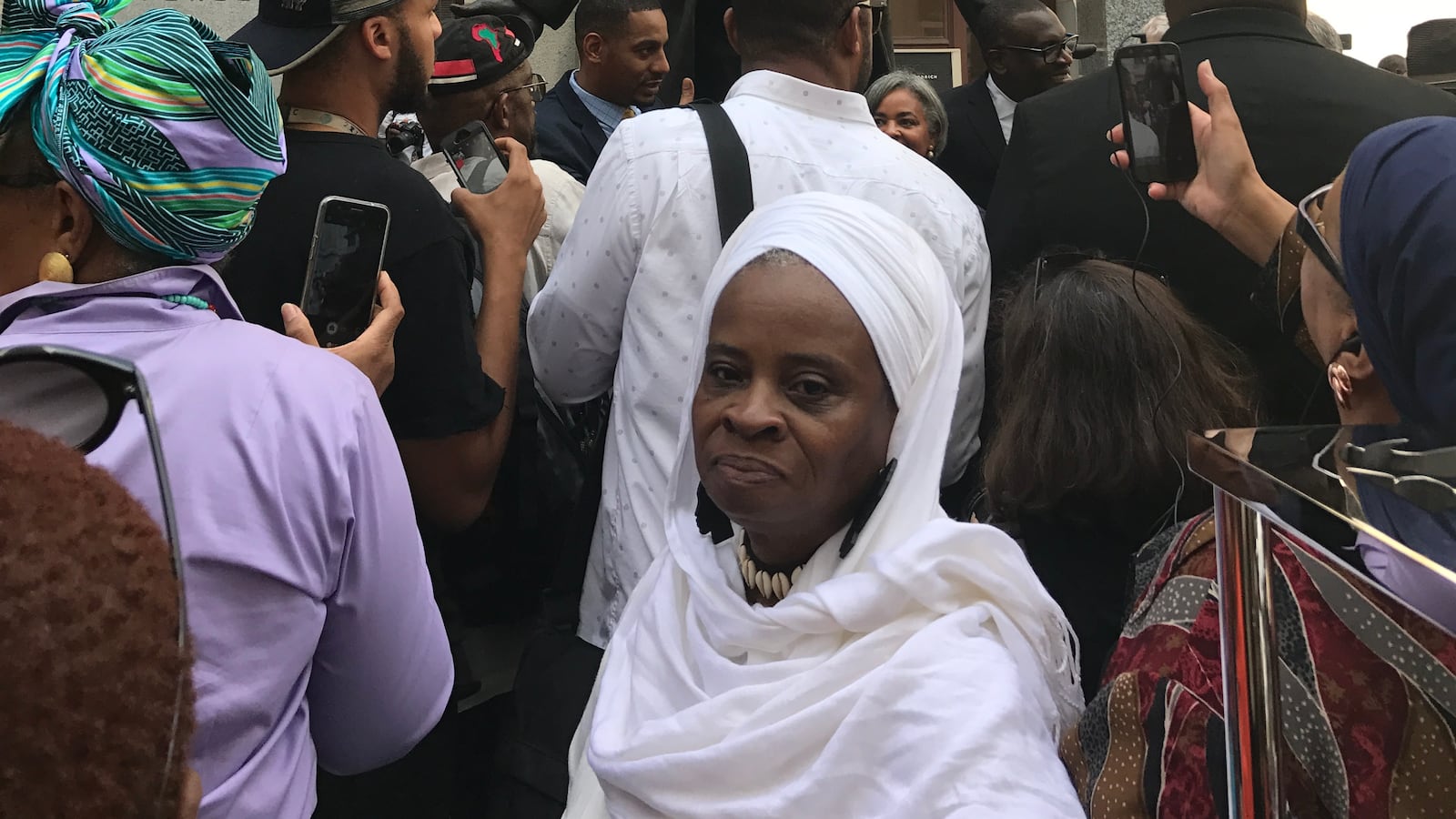This article was originally published in The Notebook. In August 2020, The Notebook became Chalkbeat Philadelphia.
Maybe now, all Philadelphia students will learn in school about Octavius V. Catto. A memorial to the remarkable 19th-century black Philadelphian, designed by sculptor Branly Cadet, was unveiled Tuesday on the south side of City Hall – a statue of Catto striding away from a series of pillars abstractly modeling a Philadelphia streetcar, on which is etched tribute to his role as an athlete, educator, soldier, activist, and political leader. Catto, who lived just 32 years, led a boycott of the horse-drawn Philadelphia streetcars because they refused to allow blacks to ride. The granite pillars are both light and dark colored, representing their desegregation largely as a result of his leadership. The 12-foot-high figure strides toward a globe-shaped ballot box, a style that was popular in the 19th century. You can see yourself and those around you reflected in the shiny globe, slightly distorted by the roundness, an experience that, in this context, conjured up all kinds of feelings about "we, the people." The work is titled Quest for Parity. Catto was also a pioneer baseball player, organized black regiments to serve in the Civil War, and was principal of male students at the Institute for Colored Youth, which he also attended, which later became Cheyney University. Besides his efforts to desegregate the streetcars, he crusaded for ratification of the 15th Amendment, which granted black men the right to vote. Then, on Oct. 10, 1871, he was shot at Ninth and South Streets on his way to cast his ballot. The date is etched below the ballot box in the memorial. His killer was an Irishman named Frank Kelly, who was later acquitted by an all-white jury. Students from several nearby schools attended the event, along with hundreds of civic leaders, donors to the project, Catto descendants, and ordinary Philadelphians. Reenactors from the Military Order Loyal Legion of the United States Third Regiment, United States Colored Troops, fired their muskets. Canon Martini Shaw, rector of the African Episcopal Church of St. Thomas, which Catto attended, said a prayer. Also present among the guests of honor were Dan Biddle and Murray Dubin, former Inquirer reporters who wrote a book about Catto published in 2011 called Tasting Freedom: Octavius Catto and the Battle for Equality in Civil War America that revived interest in his life and impact on the city. "This has been a long time coming," said a jubilant Biddle as he was surrounded by well-wishers. The School District – which in 2005 became the first major U.S. city to mandate an African American history course for graduation – is working to make Catto’s story a standard part of the curriculum. It is co-sponsoring a series of professional development sessions for teachers, beginning with one last month at the Constitution Center that featured H. Richard Millner III, a professor of urban studies at the University of Pittsburgh. "The story of Octavius Catto has been aligned with the story of abolitionism in Philadelphia, the free Black community in Philadelphia, the impact of the reconstruction era on Northern cities, and the long history of the fight for Civil rights in American society. Catto is not explicitly mentioned by name but his story can be incorporated in the U.S. History course as well as the American history course multiple times throughout the school year," said an email from Yaasiyn Muhammad, a social studies curriculum specialist. As part of the professional development for social studies and language arts teachers, those teachers are "developing projects and units that will adapt the Catto material to best serve the students in their classrooms and schools," Muhammad said.
Some students are already learning about Catto. "We got to be a part of something that was amazing. He was an amazing person. We’re really lucky to be here today," said Nile Shareef-Trudeau, a 9th grader at Science Leadership Academy who lives in Germantown, as she left the unveiling. She said her class was learning about Catto in the first few weeks of school. "We watched a documentary about him, we heard this was happening and our teacher said this was a great opportunity to go and see the unveiling of this statue." Her schoolmate, Mo Kelly, was also glad to be there. "In our African American history class, we’ve been learning about inequality, and we just wanted to see this memorial and this monument because it’s really important for African American people and it’s really important for Philadelphia," said Mo Kelly, a student at SLA from Fairmount. She said that until now, she had not known about Catto. At one time, Philadelphia had a school named after Catto. The Octavius Catto school near the University of Pennsylvania campus was, in the late 1980s, one of three "discipline schools" that were in the District for students who had gotten into trouble. The building, at 42nd and Ludlow, is now Paul Robeson High School for Human Services, named after another historically pivotal and multi-talented black Philadelphian. https://vimeo.com/235645418?loop=0


